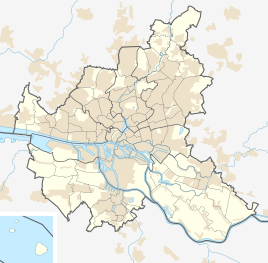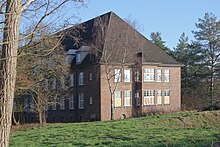Röttiger barracks
|
|
|||
|---|---|---|---|

Old western entrance |
|||
| country | Germany | ||
| today | New development area | ||
| local community | Hamburg | ||
| Coordinates : | 53 ° 28 ' N , 9 ° 49' E | ||
| Opened | 1938-1940 | ||
| Old barracks names | |||
| 1938-1944 | Panzer barracks |
|
|
| Formerly stationed units | |||
| before 2004: parts of the 3rd Panzer Division before 1948: parts of the British Rhine Army before 1945: 69th Infantry Regiment, 20 and 50 pioneer companies |
|
||
|
Location of the Röttiger barracks in Hamburg |
|||
The Röttiger barracks was a barracks complex in Hamburg-Neugraben-Fischbek that was used by the military from 1938 to 2004. The Fischbeker Heidbrook residential area is being built on the former barracks site .
history
As the Fischbek tank barracks , construction began in 1938 for the Wehrmacht , which was intended to house the 19 Panzer Regiment and the 20 reconnaissance division . However, the beginning of the Second World War initially caused delays, construction work was stopped in 1939 and individual buildings were not finished until 1940. A battalion of the 69th Infantry Regiment and a few engineer units were then placed in the finished parts .
After the end of the war, the British Army took over the site as a denazification camp, reception center for refugees and troop accommodation. From April 1948, including the numerous Nissen huts , the responsibility of the Hamburg social administration passed, which initially continued to look after the refugee camps and also set up an old people's home.
The facilities were taken over by the Bundeswehr in 1959 when it was built up and renamed Röttiger barracks on September 14, 1962 , after the first inspector of the army, Hans Röttiger . To an area of 55 ha extending area included a connected training area , a private station, the closet North and other military infrastructure as an ammunition and supply depots and a medical center. In the following years from 1960 to 1964, the Bundeswehr expanded the area into the largest barracks in Hamburg. It mainly housed the staff and units of the 7th Panzer Grenadier Brigade . An administration building for the site administration was located directly adjacent on the north side of Cuxhavener Strasse , and there was a sports field, three sports halls and a thermal power station directly on the barracks area. The oldest buildings from the late 1930s were located near Cuxhavener Strasse, in the central part there was a place for formal training and accommodation buildings from the 1960s, in the southern part there were the vehicle hangars and the technical area. Up to 1,300 soldiers were stationed on the site during the Cold War .
When the troops were reduced in the 1990s, several units to be resolved from dissolved locations in Hamburg (e.g. medical battalion 3 from Heimfeld, repair company 170 and Panzergrenadier battalion 173 from Rahlstedt) were housed at the site.
In March 2004, the last Bundeswehr units left the barracks.
| Formerly stationed units of the Bundeswehr |
|---|
|
Reuse
The first public discussions and planning for the future use of the site began as early as 2002 - before the Bundeswehr left. In 2007 they initially led to the master plan for the Röttiger barracks and the Fischbeker Heide training area . From November 2010 extensive demolition work took place, which dragged on until 2014. Two large accommodation buildings at the former northeast entrance have been preserved and will be included in the future use of the area. After a total of more than ten years of planning, the decision was made to build mainly residential buildings and buildings for local supply on the site.
IBA Hamburg has been responsible for the project development, development and marketing of the residential area, now known as Fischbeker Heidbrook, since 2013 . By 2019, around 1,200 residential units in single-family, semi-detached and terraced houses as well as small-scale apartment buildings will be built on an area of around 54 hectares. In the spring of 2015, the IBA Hamburg started marketing the first property in Fischbeker Heidbrook.
The use of the two remaining accommodation buildings has also been clarified since 2017. The existing buildings are expected to be converted into barrier-free apartments suitable for the elderly by the end of 2019 .
In order to preserve the extensive stock of trees in the future residential area, the conventional method of bombing explosives (with extensive excavations and clearing) was dispensed with. Instead, the review of the area was successfully completed by evaluating aerial photographs, researching military history and making selective excavations.
Former training site
The nearly 300 ha large training area for Röttiger barracks and other barracks in the district of Harburg was entirely on the territory of the municipality Neu Wulmstorf directly to the Fischbeker Heide adjacent and connected by an access to the barracks. It had the shape of an elongated triangle, the north-western tip of which formed the entrance to the barracks area. The training area was accessed through a Panzerringstrasse , on which there was a tank washing facility in the northern part , and the firing ranges and an ammunition depot in the south-western part .
The site is to be largely preserved as a near-natural heathland with small forests and wetlands. For the northern part, the community of Neu Wulmstorf is planning a 15-hectare new residential area with 60 building sites, which will be fully developed via the former Panzerringstrasse and thus connected to the new residential area on the old barracks site. The paved Panzerringstrasse should be preserved and continue to allow access to the entire site.
photos
Others
In 1983 the NDR turned an amount there about the Panzergrenadierbataillon 72 as part of the final exercise Weiter Jump .
literature
- Ekkehart Schmidt-Riediger: History of the Röttiger barracks in Hamburg-Fischbek . In: The archer . Association of the Army Air Defense Force e. V., December 1, 2014, ISSN 2196-0488 ( online (PDF) [accessed January 12, 2015]).
- Ole Jochumsen, Timo Korte: New uses for the Röttiger barracks . Ed .: Technical University Hamburg-Harburg . 2002 ( online (PDF) [accessed January 14, 2015]). , also contains maps and an overview of the military facilities before conversion
- Development plan for the area of the former Röttiger barracks. Retrieved January 17, 2015 .
- Harburg district for the Hamburg metropolitan region (ed.): Master plan Röttiger barracks and Fischbeker Heide training area . A&O Fischer, Winsen / Luhe 2007 ( published inter alia by the Neu Wulmstorf community [accessed on January 20, 2015]). ,
Web links
- MGFA.de - location database of the Military History Research Office Potsdam (units stationed in the Röttiger barracks and on the location training area can be reached by searching for postcode 21149)
- History of the barracks on a website of the traditional association of the Panzer Grenadier Battalion 71 (essentially identical to old information from the Wikipedia article on Neugraben-Fischbek)
- Presentation of the conversion projects in Neugraben-Fischbek
Individual evidence
- ↑ Thomas Hirschbiegel: People will soon live where there used to be tanks . In: Hamburger Morgenpost , July 28, 2013. Retrieved January 12, 2015.
- ↑ When the Bund came to Hamburg . In: Welt am Sonntag , March 26, 2006; accessed on January 12, 2015.
- ↑ a b Röttiger barracks: Now everything has to go. In: Hamburger Abendblatt. November 18, 2010. Retrieved November 16, 2018.
- ^ A b Thomas Hirschbiegel: Living instead of cannons . In: Hamburger Morgenpost , July 20, 2013. Retrieved January 19, 2015.
- ↑ Edgar Hasse: Röttiger barracks: approaching to step away . In: Die Welt , November 20, 2003; accessed on January 16, 2015.
- ↑ Fischbeker Heidbrook. naturverbunden.wohnen.de; accessed on December 16, 2015.
- ↑ Article in the Hamburger Abendblatt , November 22, 2017; on the so-called "senior village" accessed on December 7, 2017.
- ↑ Jochen Gipp: How dangerous is the shooting range in the Wulmstorfer Heide? In: Hamburger Abendblatt ; accessed on January 22, 2015.
- ^ Representation of the Wulmstorfer Heide area on the website of the City of Hamburg; accessed on January 21, 2015.
- ↑ NDR documentary "Weiter Sprung '83" on Youtube






